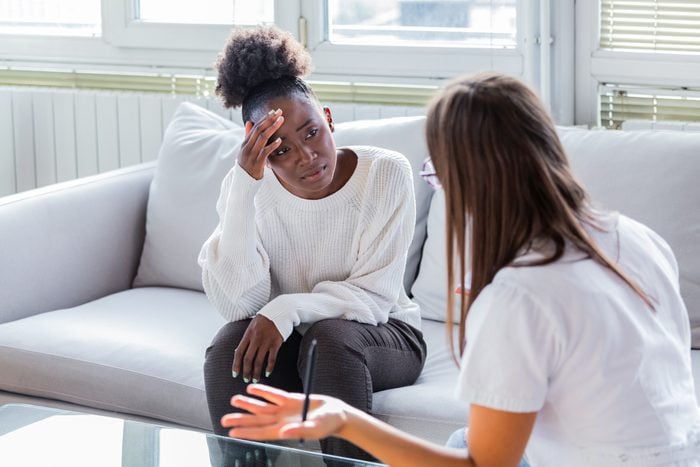
When you reach out to find a therapist, there’s a decent possibility it’s because something in your life has reached a head that you need help coping with or managing through. Data since the start of the pandemic suggest that 20% to 30% of Americans count psychotherapy as part of their regular routine. Yet, one 2020 study suggested it’s common for individuals to find it challenging to open up to a mental health professional, especially when they’re first engaging their therapist’s support.
It’s probably not a big surprise that most therapists are clued-in to your general state based on nonverbal cues. Many psychotherapists are trained to spot subtleties and behaviors you may not even be aware of to help inform the most effective treatment plan
Even so, explains Katie Bingner, LCPC, a licensed mental health counselor and communication coach, first impressions don’t tell the whole story. “Non-verbal communication means different things across different cultures, so consideration must be taken,” she says. So, while many therapists tend to notice these eight things about you at first glance, curiosity—not judgment—is the intention behind gathering insights…with the ultimate goal of helping you improve your mental health.

1. Your clothing
“I take note of their clothing,” says Holly Schiff, PsyD, a licensed clinical psychologist in Connecticut. If someone comes in clearly not having showered in days and wearing clothes that are wrinkled and look slept in, these can be signs they’ve been in distress.
3 Major Toxins Have Been Found in Popular Clothing Brands—Here’s What to Know

2. Your appearance
“Hygiene and grooming are other physical indicators I look for that can provide insight into how someone is doing,” Dr. Schiff says. Cues might include dark circles under the eyes that can hint at issues causing sleeplessness, or a noticeable shift in weight can suggest a change in eating behaviors caused by stress.

3. Eye contact
“The way someone holds eye contact with you can provide insight into how confident or insecure they feel, how anxious or uncomfortable they are—and it isn’t always what you think,” Bingner says. “For example, holding inappropriately intense, direct eye contact could suggest that the person feels a very deep sense of insecurity, with which they cope by attempting to intimidate others.”
Still, some people have a hard time making eye contact at all, which can be a sign of nervousness, discomfort, and not wanting to engage. “Rapid blinking can mean they’re stressed or upset,” too, adds Dr. Schiff.

4. Your facial expressions
Facial expressions can also provide clues into someone’s emotional state, says Lillian Rishty, LCSW, a therapist with NYC Therapy Group. In particular, limited expression—also known as a “flat affect”—is often linked with conditions like depression, she says.
Feeling Depressed? Change This One Common Habit, Says New Study

5. Repetitive behaviors
Maybe you tap your feet, jiggle your legs, or play with something in your hands—all possible signs that you’re tense and nervous, Dr. Schiff says. “Sometimes people will hold something to put a protective barrier in front of them, like a pillow, a handbag, or a jacket,” she says. “Sometimes people will rub a certain part of their body or run their fingers over something back and forth as a way to self-soothe.”
Research Shows This Gross (but Common) Behavior May Increase Alzheimer’s Risk

6. Your body language
“Body language makes up a large portion of our overall communication, so I definitely notice how people use their bodies to tell their stories,” Dr. Schiff says. Posture says a lot about how comfortable someone is, for instance. “People might shift back and forth, turn their body or feet away from the therapist, or slouch in their chair,” she says.
And if someone crosses their arms or legs, it’s often a sign of discomfort, either in general or about a specific topic.

7. Speech patterns
Patterns in what you say can say a lot, according to Ashley J. Smith, PhD, a licensed psychologist and co-founder of Peak Mind: The Center for Psychological Strength. Specifically, “what ifs” signal a worry process, often associated with Generalized Anxiety Disorder or Obsessive Compulsive Disorder, she says. If she hears a lot of “yeah, but’s,” that’s another red flag: Like if something goes well, but you respond with “Yeah, but I just barely got through it.” This is indicative of a cognitive bias—a thinking error or brain trick—called discounting the positive, Dr. Smith says, and it’s a risk factor for depression and anxiety.
Larger speech patterns can offer insights, too. “I observe [their] ways of talking,” says Maryam Elbalghiti-Williams, LCSW-C, owner and Therapist of Maryam Yasmin Therapy & Consulting. “Are they able to present a cohesive narrative that follows a timeline, or do they jump around a lot? Straying off topic and gaps in memory signal to me as the clinician that there is some digging needed to assess for issues like trauma, anxiety, or ADHD.”
5 Common Statements an Eating Recovery Psychologist Says We All Need to Avoid

8. Your tone of voice
It’s not just about listening to what someone says—but how they say it. If someone’s speaking slowly and softly, it could indicate sadness and embarrassment, Dr. Schiff explains. “They may be sharing something painful or hard to talk about, or maybe something they haven’t shared before.” She adds that higher-pitched or faster-than-usual speech could suggest someone’s nervous, fearful, or possibly being dishonest.
Meanwhile, “a flat, monotonous tone could be indicative of depressive symptoms,” adds Rishty.
Get The Healthy @Reader’s Digest newsletter and follow The Healthy on Facebook, Instagram, and Twitter. Keep reading:
